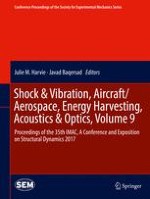2017 | Buch
Shock & Vibration, Aircraft/Aerospace, Energy Harvesting, Acoustics & Optics, Volume 9
Proceedings of the 35th IMAC, A Conference and Exposition on Structural Dynamics 2017
herausgegeben von: Julie M. Harvie, Javad Baqersad
Verlag: Springer International Publishing
Buchreihe : Conference Proceedings of the Society for Experimental Mechanics Series
